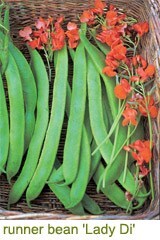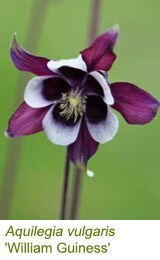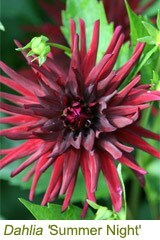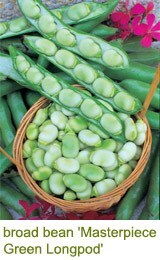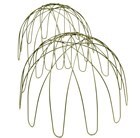Aromatics for Full Sun
Aromatic plants produce their own fragrant oil and they use it as a sunscreen to prevent scorching, so anything aromatic or silvery needs full sun. Although drought-tolerant, these plants rely on a deep root system and once established they will never need watering, or feeding. When you plant a silver or aromatic plant however, it must be coached through its first season, so water it regularly. After that it will put down fine roots that go down for two or three feet and you need never water again.
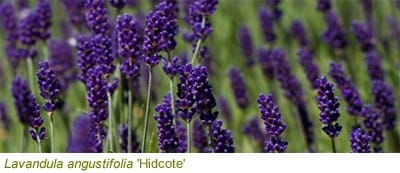
The quintessential aromatic is lavender and there are three basic types on offer. English lavender (Lavandula angustifolia) is the hardiest of all and it produces low-growing plants with fine foliage topped by summer flowers that are held on short stems, just above the leaves. It's compact enough for the front of the border, or train it as a low hedge. Good forms include the deep blue 'Hidcote', the highly regarded blue 'Little Lady' and the lilac 'Munstead'.
 If you wish to dry the flowers pick them early, usually in the last week of Wimbledon. Hard pruning isn't a problem, so this type of lavender should be cut back hard every August so that it reshoots and overwinters. Treated like this it will live for twenty-five years. It can also be given a Chelsea chop, reduced by a third in May, to produce flowers that appear later and follow the main flush of roses. 'Melissa Lilac' is also a stunner, with large flowers in the English lavender mould, but this will not take a hard prune. If you wish to dry the flowers pick them early, usually in the last week of Wimbledon. Hard pruning isn't a problem, so this type of lavender should be cut back hard every August so that it reshoots and overwinters. Treated like this it will live for twenty-five years. It can also be given a Chelsea chop, reduced by a third in May, to produce flowers that appear later and follow the main flush of roses. 'Melissa Lilac' is also a stunner, with large flowers in the English lavender mould, but this will not take a hard prune.
The second is known as a lavendin and this hybrid flowers in late summer producing billowing foliage and long stems topped with tapering slender flowers. Named L. x intermedia, these make good statement plants but they are not as hardy. Round the plants off every autumn, when flowering becomes ragged, but never cut them back hard. This autumn trim produces rounded plants that have good winter presence. 'Grosso' is the form grown all around Provence, for oil production, but the foliage is a fresh-green rather than grey. The purple flowers splay outwards from the foliage.
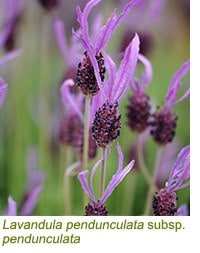 Finally the tufted lavenders, with petals that stick out of the top, are the least hardy so they only tolerate being lightly trimmed in May or June, after their first flush of flower. Good forms include the burgundy and purple 'Helmsdale' and the pink-tufted 'Rocky Road'. The most elegant is Spanish lavender, Lavandula pedunculata subsp. pedunculata, with very long waving petals that constantly shimmy and sway in the slightest breeze. Finally the tufted lavenders, with petals that stick out of the top, are the least hardy so they only tolerate being lightly trimmed in May or June, after their first flush of flower. Good forms include the burgundy and purple 'Helmsdale' and the pink-tufted 'Rocky Road'. The most elegant is Spanish lavender, Lavandula pedunculata subsp. pedunculata, with very long waving petals that constantly shimmy and sway in the slightest breeze.
Tactile Touchables
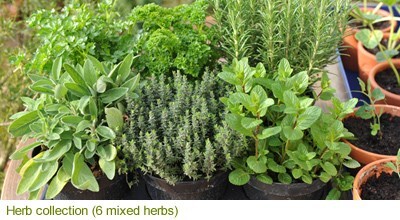
Having aromatic plants close to a sunny seat can be very soothing because the foliage is within reach of the fingers and a gentle stroke of lavender can be very soothing on a stressful day. Culinary purple sage, Salvia officinalis 'Purpurascens', mingles well with all lavenders and in hot summers the purple foliage fades to damson damask, setting off all silvers. Deep-blue flowers follow. Add a thyme or two, a green sage and some chives and they'll be useful in the kitchen as well. The Herb Collection, containing six plants, could be displayed in a wicker basket or galvanised container close to the kitchen door before being planted into the ground in autumn.
Clove-Scented Beauties
Every garden should aspire to grow the pink, or Dianthus. It's literally the flower (anthos) of Jove because these flowers were used to honour the gods. The word carnation is a derivation of coronation. Dianthus need good drainage and a completely open situation to thrive, plus unpolluted air. Given this (and a yearly trim in August) they will reappear year after year.
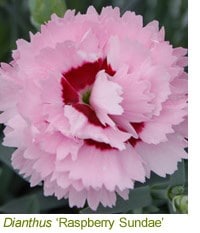 The Scent First Series contain perpetual-flowering pinks that still deliver scent. 'Raspberry Sundae' is a frilly pink with a swirl of raspberry in the middle. 'Coconut Sundae' is a white with a maroon middle and 'Candy Floss' is an all-pink dianthus of great charm. The word pink used to refer to the crimped edges of the petal, as it was not as well known as a colour until the 17th century. Pinks make excellent cut flowers, particularly when placed in a vase The Scent First Series contain perpetual-flowering pinks that still deliver scent. 'Raspberry Sundae' is a frilly pink with a swirl of raspberry in the middle. 'Coconut Sundae' is a white with a maroon middle and 'Candy Floss' is an all-pink dianthus of great charm. The word pink used to refer to the crimped edges of the petal, as it was not as well known as a colour until the 17th century. Pinks make excellent cut flowers, particularly when placed in a vase
filled with fizzy lemonade, but always snip between the bumpy nodes on the stems.
Woodbines
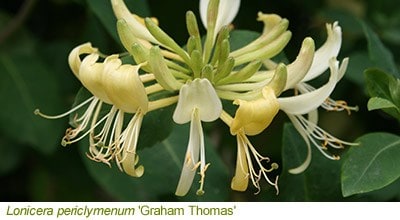
Every garden contains some shady areas and honeysuckles like to have their feet in good soil in shade, before they scramble into the sun. They take up very little ground room and they can climb trees, or drape themselves over walls, or they can be shaped into pillar shrubs although you will need to provide wire supports. When it comes to scent, it's the rhubarb and custard flowered ones that pack the punch and not the brighter orange and red American species. The latter attract hummingbird pollinators by their bright colour, not scent.
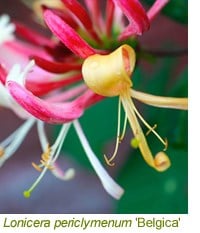 They greyer-leaved 'Graham Thomas', with custard cream flowers, is a softer alternative than the rhubarb-pink forms. 'Belgica' is the first rhubarb and custard form to flower and 'Serotina', a stronger mix of cream and purple-red, is later. Honeysuckles do take time to establish, but once they feel their feet they deliver and they make an excellent backdrop to roses. They produce bird-friendly red berries and the only maintenance is a trim back after flowering - should you wish to. If you want to plant on a wall, choose a western elevation that will deliver rainfall. They greyer-leaved 'Graham Thomas', with custard cream flowers, is a softer alternative than the rhubarb-pink forms. 'Belgica' is the first rhubarb and custard form to flower and 'Serotina', a stronger mix of cream and purple-red, is later. Honeysuckles do take time to establish, but once they feel their feet they deliver and they make an excellent backdrop to roses. They produce bird-friendly red berries and the only maintenance is a trim back after flowering - should you wish to. If you want to plant on a wall, choose a western elevation that will deliver rainfall.
Top Drawer Roses for Scent

Hybrid Musks mingle well with English honeysuckle and they are amongst the most fragrant and healthy. They perform from July onwards, after the main flush of most roses, so they are useful to the gardener. Hybrid Musks are still in the top drawer, despite being bred almost a hundred years ago, but they do need a warm position and they really resent pruning. Hold off on the secateurs and find a sunny position and 'Buff Beauty' will reward you with a profusion of soft apricot flowers displayed against reddish foliage. Or plant the lovely 'Felicia' for her generous clusters of smaller salmon-pink blooms held over coppery leaves. Hybrid musks go on late and cope with poorer soil, having been bred in the relatively dry county of Essex.
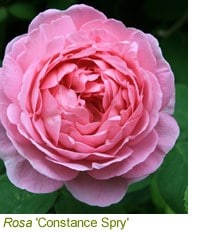 Always try to find room for a once and only rose that drips in flower in June, before fading away, because these abundant roses make June glorious in rose time. Repeat-flowering roses tend to eke out their flowers instead, producing good flushes, but they never drip with flower. 'Constance Spry' was David Austin's first rose and named after the great flower arranger and cook who gathered together the best collection of old-fashioned roses in the country at Winkfield Place, now the home of Legoland. 'Constance Spry' can be trained as a climber or grown as a large shrub, and the almost globular flowers are eye catching either way. Always try to find room for a once and only rose that drips in flower in June, before fading away, because these abundant roses make June glorious in rose time. Repeat-flowering roses tend to eke out their flowers instead, producing good flushes, but they never drip with flower. 'Constance Spry' was David Austin's first rose and named after the great flower arranger and cook who gathered together the best collection of old-fashioned roses in the country at Winkfield Place, now the home of Legoland. 'Constance Spry' can be trained as a climber or grown as a large shrub, and the almost globular flowers are eye catching either way.
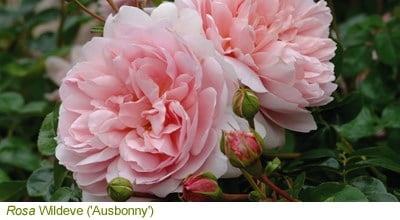
If you want a repeat-flowering pink pillar rose opt for 'Aloha', a wonderfully frilly affair with a dark pink middle to each petal-packed coral-pink bloom. This packs real fragrance and the foliage is very healthy. Or plant 'Wildeve', a later repeat-flowering pink Austin rose that produces long wands, so it's not for the windy garden. This is really healthy too and hardly ever out of flower. David Austin's 'Princess Anne' is also a good pink rose, with clusters of flower that seem to radiate shades of red to purple when freshly open. It's upright and healthy, with a medium fragrance.
Fragrant Shrubs
Certain shrubs flower with the roses and Philadelphus 'Belle Etoile' has a citrus scent. The white flowers have a subtle maroon splash that picks up the colour of pink and purple-pink roses and this compact shrub will only reach man-height. The hint of colour prevents this philadelphus from looking glacial in summer sun as well. Trim back one third of the old wood after flowering, to encourage a good shape. Other philadelphus are either too tall, or too small. This is a Goldilocks' plant and just right!
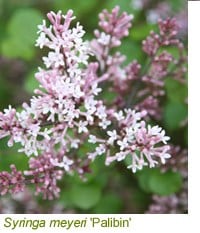 Several of the smaller-flowered lilacs are also very scented and the scent hovers between lily and rose. Syringa meyeri 'Palibin', a form of Korean lilac, has lavender-pink flowers above green foliage. This tolerant shrub is extremely hardy and flowers reliably, whether in full sun or in slight shade, and the neat foliage is good enough to shine for the rest of the year before colouring up well in autumn. It's slow growing, so an ideal plant for a small garden, or large container, and the scent is all-pervading. Several of the smaller-flowered lilacs are also very scented and the scent hovers between lily and rose. Syringa meyeri 'Palibin', a form of Korean lilac, has lavender-pink flowers above green foliage. This tolerant shrub is extremely hardy and flowers reliably, whether in full sun or in slight shade, and the neat foliage is good enough to shine for the rest of the year before colouring up well in autumn. It's slow growing, so an ideal plant for a small garden, or large container, and the scent is all-pervading.
Border Phloxes
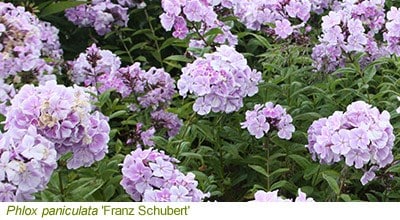
Finally don't forget about border phlox, for they provide a meadowsweet scent in July and August. Forms of Phlox paniculata pack the best fragrance and their flowers come in pink, white, lilac and shades of red, often supported by good, green foliage. Clean whites often have fresh-green foliage and 'Rembrandt' has triangular heads of white flowers with a hint of cool-green to the flowers. 'Mount Fuji', always the last to flower, has tight heads of smaller flowers. The parma- violet 'Franz Schubert' looks and smells sensational in the evening and this is a strong, easy-to-grow variety from Alan Bloom.
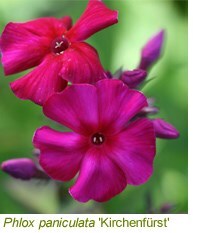 Some phlox have colourful eyes and these include the highly-fragrant 'Bright Eyes', a pale-pink with a crimson eye. Karl Foerster bred a lot of fine phlox in Germany. His 'Kirmesländler' is a white with a suffused pink-red eye. He also produced the purple-pink 'Kirchenfürst', literally meaning Prince of the Church, because the colour is just like the clerical shirts worn by Bishops. Some phlox display black-toned foliage before they flower and the almost-red 'Starfire' is worth growing for foliage alone. It's a stunner. Some phlox have colourful eyes and these include the highly-fragrant 'Bright Eyes', a pale-pink with a crimson eye. Karl Foerster bred a lot of fine phlox in Germany. His 'Kirmesländler' is a white with a suffused pink-red eye. He also produced the purple-pink 'Kirchenfürst', literally meaning Prince of the Church, because the colour is just like the clerical shirts worn by Bishops. Some phlox display black-toned foliage before they flower and the almost-red 'Starfire' is worth growing for foliage alone. It's a stunner.
|
Things to do
|

















